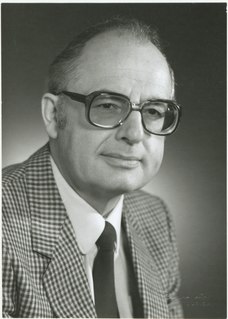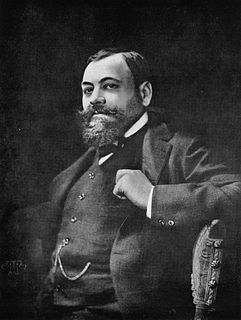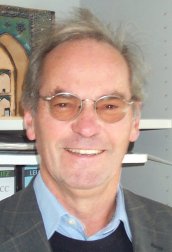
Ambergris, ambergrease, or grey amber is a solid, waxy, flammable substance of a dull grey or blackish colour produced in the digestive system of sperm whales. Freshly produced ambergris has a marine, fecal odor. It acquires a sweet, earthy scent as it ages, commonly likened to the fragrance of Isopropyl alcohol without the vaporous chemical astringency.

Leopold Ružička was a Croatian-Swiss scientist and joint winner of the 1939 Nobel Prize in Chemistry "for his work on polymethylenes and higher terpenes" "including the first chemical synthesis of male sex hormones." He worked most of his life in Switzerland, and received eight doctor honoris causa in science, medicine, and law; seven prizes and medals; and twenty-four honorary memberships in chemical, biochemical, and other scientific societies.
Firmenich SA is a private Swiss company in the fragrance and flavor business. It is the largest privately owned company in the field and ranks number two worldwide. Firmenich has created perfumes for over 125 years and produced a number of well-known flavors.

Myrcene, or β-myrcene, is a monoterpene. A colorless oil, it occurs widely is in essential oils. It is produced mainly semi-synthetically from Myrcia, from which it gets its name. It is an intermediate in the production of several fragrances. α-Myrcene is the name for the isomer 2-methyl-6-methylene-1,7-octadiene, which has not been found in nature.

Ocimenes are a group of isomeric hydrocarbons. The ocimenes are monoterpenes found within a variety of plants and fruits. α-Ocimene and the two β-ocimenes differ in the position of the isolated double bond: it is terminal in the alpha isomer. α-Ocimene is cis-3,7-dimethyl-1,3,7-octatriene. β-Ocimene is trans-3,7-dimethyl-1,3,6-octatriene. β-Ocimene exists in two stereoisomeric forms, cis and trans, with respect to the central double bond. The ocimenes are often found naturally as mixtures of the various forms. The mixture, as well as the pure compounds, are oils with a pleasant odor. They are used in perfumery for their sweet herbal scent, and are believed to act as plant defense and have anti-fungal properties. Like the related acyclic terpene myrcene, ocimenes are unstable in air. Like other terpenes, the ocimenes are nearly insoluble in water, but soluble in common organic solvents.
The terpinenes are a group of isomeric hydrocarbons that are classified as monoterpenes. They each have the same molecular formula and carbon framework, but they differ in the position of carbon-carbon double bonds. α-Terpinene has been isolated from cardamom and marjoram oils, and from other natural sources. β-Terpinene has no known natural source but has been prepared from sabinene. γ-Terpinene and δ-terpinene have been isolated from a variety of plant sources. They are all colorless liquids with a turpentine-like odor.
Jack David Dunitz FRS was a British chemist and widely known chemical crystallographer. He was Professor of Chemical Crystallography at the ETH Zurich from 1957 until his official retirement in 1990. He held Visiting Professorships in the United States, Israel, Japan, Canada, Spain and the United Kingdom.

François Diederich was a Luxembourgian chemist specializing in organic chemistry.

Albert Jakob Eschenmoser (born 5 August 1925) is a Swiss organic chemist, best known for his work on the synthesis of complex heterocyclic natural compounds, most notably vitamin B12. In addition to his significant contributions to the field of organic synthesis, Eschenmoser pioneered work in the Origins of Life (OoL) field with work on the synthetic pathways of artificial nucleic acids. Before retiring in 2009, Eschenmoser held tenured teaching positions at the ETH Zurich and The Skaggs Institute for Chemical Biology at The Scripps Research Institute in La Jolla, California as well as visiting professorships at the University of Chicago, Cambridge University, and Harvard.

Traugott Sandmeyer was a Swiss chemist after whom the Sandmeyer reaction, which he discovered 1884, was named.

Eugen Bamberger was a German chemist and discoverer of the Bamberger rearrangement.
Headspace technology is a technique developed in the 1980s to elucidate the odor compounds present in the air surrounding various objects. Usually the objects of interest are odoriferous objects such as plants, flowers and foods. Similar techniques are also used to analyze the interesting scents of locations and environments such as tea shops and saw mills. After the data is analyzed, the scents can then be recreated by a perfumer.

Philip Kraft is a German organic chemist. Since 1996 he has been employed by Givaudan, a leading Flavor and Fragrance company, where he designs captive odorants for use in perfumes. He has lectured at the University of Bern, the University of Zurich, and the ETH Zurich.

Paul Parquet (1856–1916) was a French perfumer and joint owner of Houbigant. Called the "greatest perfumer of his time" by Ernest Beaux, he is widely regarded as the founder of modern perfumery for having pioneered the use of synthetics in works such as Fougère Royale. His bestselling perfume, Le Parfum Idéal, was described by Robert Bienaimé as a “masterpiece of fragrant equilibrium, harmonious and of good taste as shall never be surpassed”.
István T. Horváth was a Hungarian American chemist, working on greener and more sustainable chemistry since its inception. In particular, he focuses on homogeneous transition metal catalysis and in situ spectroscopy. He was highly involved and very influential in the now enormous field of fluorous solvents and technologies.

Vincenzo Balzani is an Italian chemist, now emeritus professor at the University of Bologna.
Günther Ohloff was a prominent German fragrance chemist.

Pomarose is a high-impact captive odorant patented by Givaudan. It is a double-unsaturated ketone that does not occur in nature. Pomarose has a powerful fruity rose odor with nuances of apples, plums and raisins, which is almost entirely due to the (2E,5Z)-stereoisomer, while its (2E,5E)-isomer is barely detectable for most people. Catalyzed by traces of acids, both isomers equilibrate however quickly upon standing in glass containers.

Foil Allan Miller was an American chemist and philatelist best known for his work in infrared and Raman spectroscopy. He was head of the spectroscopy division of the Mellon Institute and later professor and head of the spectroscopy laboratory at the University of Pittsburgh. Among other publications, he co-authored the books Course Notes on the Interpretation of Infrared and Raman Spectra (2004) and A Philatelic Ramble Through Chemistry (1998).

Johann Gasteiger is a German Chemist and a Chemoinformatician on which he wrote and edited various books.














